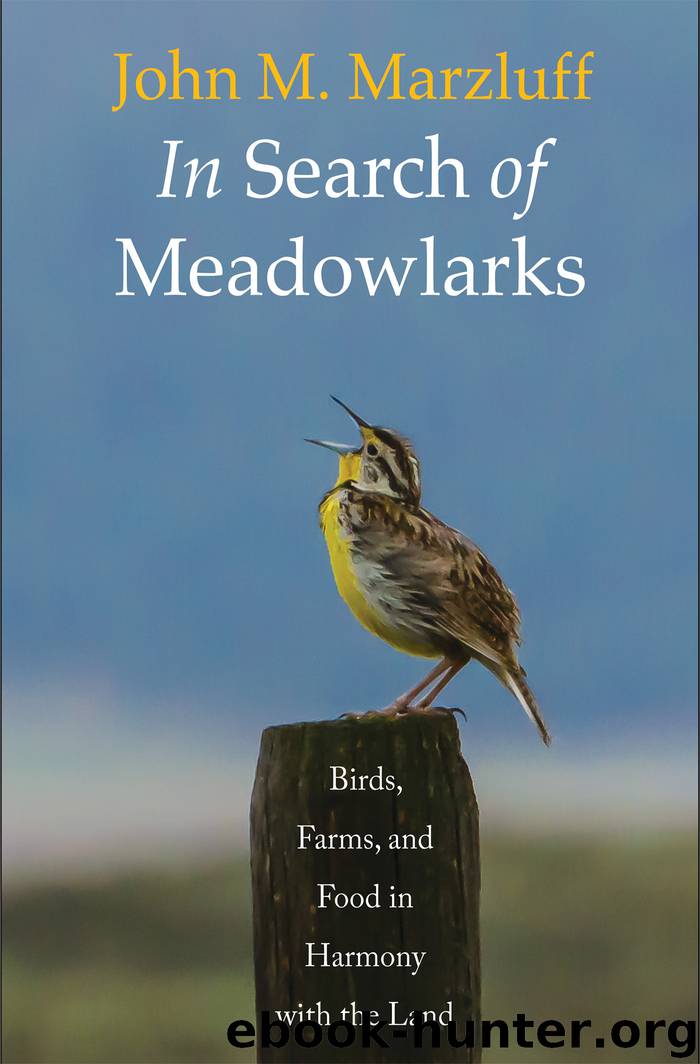In Search of Meadowlarks by John M. Marzluff

Author:John M. Marzluff
Language: eng
Format: epub
Publisher: Yale University Press
Published: 2020-03-17T16:00:00+00:00
NINE
The Luxury of Meat
A sandhill crane surveys its breeding territory next to the Anderson Ranch.
A WORLD AWAY FROM THE TROPICAL forests and small farms of Central America, cold streams drain high peaks and throw wide meanders through flatter, fertile land. Here in Montana, the high-quality grass, which, depending on elevation, is tender from March through August, proved irresistible to midwestern cattlemen. In the mid-1800s, they began annual cattle drives from Texas and elsewhere to fatten up on Montana’s opulent pastures. It wasn’t long before huge ranches came to dominate the region, occupying, for example, both shores of the Yellowstone River as it left the national park swinging east to the Missouri. Ranching and farming still dominate the Montana landscape and economy, though the average spread has shriveled a bit. There are more than twenty-eight thousand farms and ranches occupying 63 percent of its vast—147,000-square-mile—landscape. Wheat and other crops, such as those grown in the Three Forks area (see chapter 4), occupy the eastern prairies, but cattle and sheep are kings along the flanks of the scattered mountain ranges that rise from the prairie. Unlike in the Midwest, where cattle are fed corn and other grains in large stockyard operations, in Montana most cattle eat their natural food, grass. Many graze solely on native grasses, following the snowmelt up in elevation each summer to feed on the young shoots of fescue, wheatgrass, bluegrass, and basin wild rye. Others are more confined on pastures, where alfalfa hay supplements the fresh brome and timothy grass.
Unlike a cornfield, ranchland holds excellent promise for wildlife. Natural vegetation—habitat for animals—can be maintained because the ground is neither plowed nor paved. And because the infrastructure is minimal, ranchland can be extensive; nearly 10 percent of Montana today is nonirrigated ranch and farmland. However, on the traditional ranch, the needs of wildlife and livestock are often at odds with one another. Deer and elk compete with cows for grass to the dismay of ranchers. Fences can block or trap big game and reduce the safety of wide-open lands for prairie grouse. Conversion of native ground to pasture frequently preempts wildlife migration to traditional lowlands during the winter. The shrubs and trees that grow along rivers make perfect nesting thickets for migratory birds, such as the yellow warbler. However, when cattle are turned out to graze, they seek water several times a day, and in the process, they often trample or overgraze the streamside to the detriment of native birds. To reduce herd losses, ranchers helped champion the idea of predator control, which eliminated wolves from most of the United States by the early 1900s and significantly reduced other large carnivores, such as the mountain lion. No wonder foxes and coyotes are shy and often afoot when seen on a ranch. And wolves continue to find few friends among ranchers. With wolves’ reintroduction to Yellowstone National Park in 1995, their control has returned as a conservation issue. For example, in 2015, U.S. government hunters killed thirty-two Montana wolves after
Download
This site does not store any files on its server. We only index and link to content provided by other sites. Please contact the content providers to delete copyright contents if any and email us, we'll remove relevant links or contents immediately.
Craft Beer for the Homebrewer by Michael Agnew(18140)
Marijuana Grower's Handbook by Ed Rosenthal(3619)
Barkskins by Annie Proulx(3312)
Project Animal Farm: An Accidental Journey into the Secret World of Farming and the Truth About Our Food by Sonia Faruqi(3177)
The Plant Messiah by Carlos Magdalena(2883)
Red Famine: Stalin's War on Ukraine by Anne Applebaum(2873)
0041152001443424520 .pdf by Unknown(2784)
Organic Mushroom Farming and Mycoremediation by Tradd Cotter(2626)
In the Woods by Tana French(2532)
Beer is proof God loves us by Charles W. Bamforth(2370)
7-14 Days by Noah Waters(2361)
Reservoir 13 by Jon McGregor(2242)
Borders by unknow(2227)
Meathooked by Marta Zaraska(2220)
The Art of Making Gelato by Morgan Morano(2216)
Birds, Beasts and Relatives by Gerald Durrell(2175)
Between Two Fires by Christopher Buehlman(2164)
The 7 Habits of Highly Effective People: Powerful Lessons in Personal Change (25th Anniversary Edition) by Covey Stephen R(2139)
The Lean Farm Guide to Growing Vegetables: More In-Depth Lean Techniques for Efficient Organic Production by Ben Hartman(2096)
